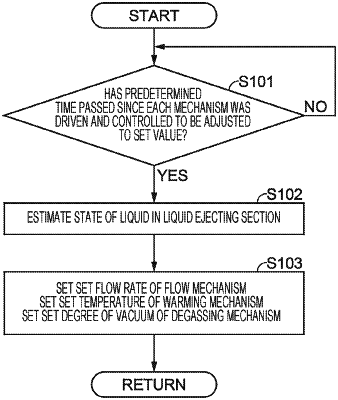| CPC B41J 2/04563 (2013.01) [B41J 2/04508 (2013.01); B41J 2/04571 (2013.01); B41J 2/04581 (2013.01); B41J 2/18 (2013.01); B41J 2/19 (2013.01)] | 14 Claims |

|
1. A liquid ejecting apparatus comprising:
a liquid ejecting section that ejects a liquid from a nozzle;
a circulation flow path including a supply flow path through which the liquid is supplied to the liquid ejecting section and a return flow path through which the liquid supplied to the liquid ejecting section is returned;
a warming mechanism including a temperature control module provided in the circulation flow path, the warming mechanism being configured to heat the liquid in the temperature control module;
a flow mechanism that flows the liquid in the circulation flow path;
a state detection unit that detects a state of the liquid in the liquid ejecting section; and
a controller,
wherein the controller executes a first control that sets a temperature of the liquid in the temperature control module to a set temperature by controlling the warming mechanism and controls the flow mechanism to circulate the liquid in the circulation flow path at a set flow rate,
the controller estimates a viscosity of the liquid in the liquid ejecting section from a detection result detected by the state detection unit when a predetermined time has elapsed during the execution of the first control, and
the controller executes a second control that maintains the set temperature and controls the flow mechanism to circulate the liquid in the circulation flow path by changing the flow rate from the set flow rate to a flow rate corresponding to the estimated viscosity of the liquid.
|